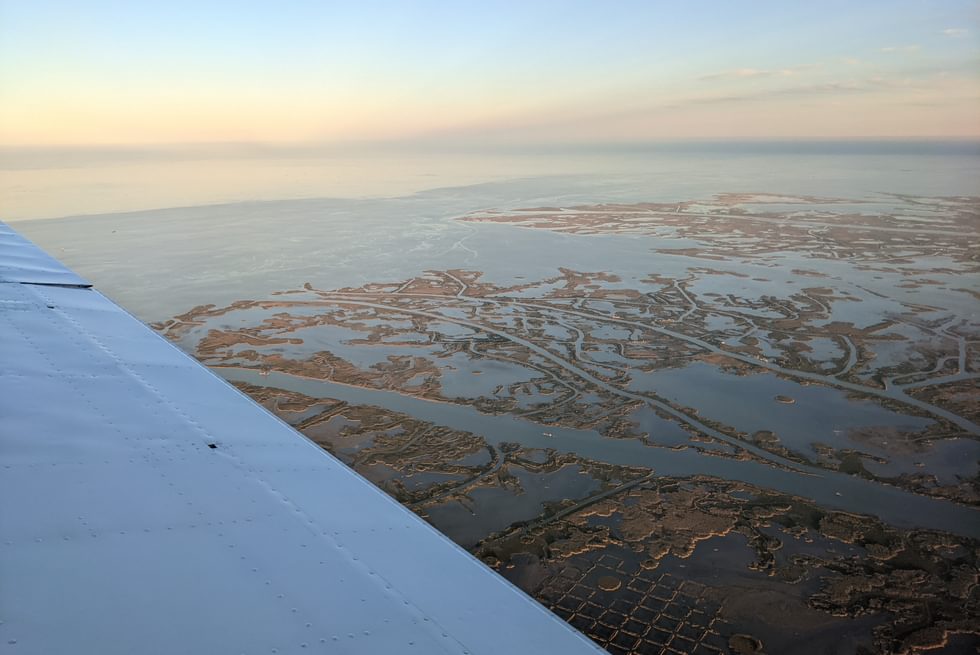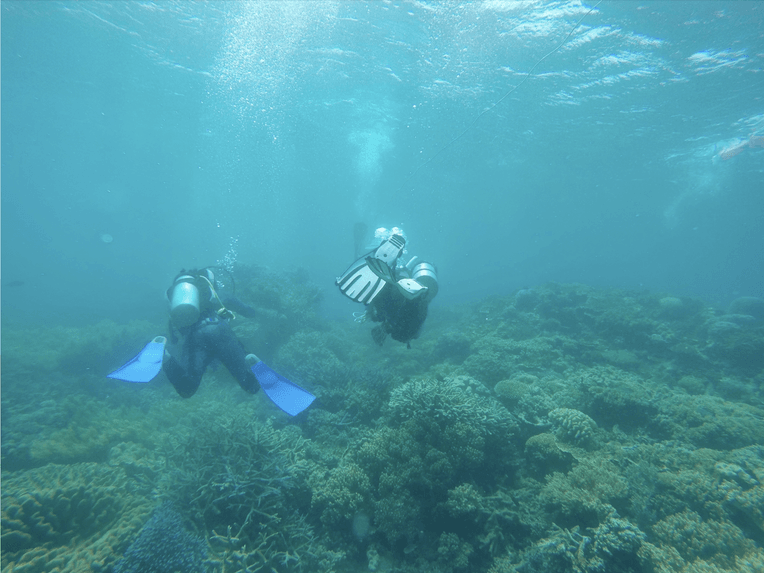Nudging the Reef: Underwater Care and Assisted Recovery in Marine Restoration
From the Series: Coastal Futures
From the Series: Coastal Futures

As divers descend into Australia’s Great Barrier Reef to visit a restoration site, the moon beams down onto the water, still and mirrorlike. The surface disappears, and they move between worlds to reach a reef once dotted white under the stress of the 2016-17 mass bleaching. Torches illuminate the dark, and the reef is alive. They are twenty feet under now and, navigating through the cloudy haze emanating from the Porites coral, they find a large boulder coral spawning. Small bundles of pink are pushed from the coral’s groves, drifting slowly through the water. Worms dance like ribbons and silver fish flitter to their lights. The scene is frenetic and the divers watch as coral polyps release their spawn, peppering the dark like stars. Reaching their destination, they find that the restoration site has, for the first time, also spawned; relief washes over the group. They have “nudged” the reef to new life.

At vulnerable reefs—increasingly threatened by elevated sea surface temperatures and the unbalancing effects of industrial runoff and costal development—marine restorations enact a practice of intimate and engaged human intervention. They harness an anthropogenic output of caring via the fragmenting, attaching, cleaning, and nurturing of what restorationists refer to as coral “babies.” This hands-on work comes to a close only when new life starts to spawn, fertilise, settle, and grow. Spawning, a marine biologist explains in an interview, “is one of those bright spots of hope. We can only have so much impact through out-planting, but if those out-plants go on to spawn and contribute hundreds of millions of new coral babies; that’s magnifying our impact to places we won’t ever get to go.” The spawn of coral fragments once suspended on underwater frames, toothbrushed and monitored by restoration divers, extends care-ful practice to perceptible flourishing, supporting a picture of recovery that reaches beyond the scale of what is possible with human hands alone.
If we think about restoration as a practice of making life live, of assisting recovery with intentional nudges, we begin to appreciate how at each stage of restoration, the nurturing of nonhuman life enables the care of multispecies connections that are “dynamic, dialogical, (and) embodied” (Desai and Smith 2018, 45). Here, reef restoration emerges as a means by which people engage actively in the curation of reef health and resilience “for their own survival as much as for the survival of that ecosystem” (Meyers 2017, 202). These enactments of underwater care are based on an acknowledgement of relationality—of being in relation to and with reef others who oscillate between thriving and surviving in contexts of shared anthropogenic risk and intervention. Yet, while reef restoration in Australia is premised on the value, and virtue, of planned human-assisted recovery in marine environments, it cannot be forgotten that the reef also acts; it too intervenes, propelled by the actions and reactions of myriad underwater organisms engaged in their own relationalities of care. Restoration nudges in this multi-actor assemblage emerge as mutual and engaged, not limited to the human actions supporting the resilience of vulnerable reefs.
It is in recognizing the potential for enabling the capacity for self-care and self-recovery that reef restoration nudges are resulting in novel practices. In South Australia, for instance, marine biologists are working to bring back the oyster beds for Ostrea angasi that were decimated soon after the onset of settler colonization in the mid-1800s. Their efforts at making life live focus on creating the underwater infrastructure to which oyster larvae can attach and thrive. By laying concrete boulder reefs in test locations across the southern coastline, they are inviting back and “recruiting” an ecosystem known to magnify biodiversity indices and increase fish populations. Like the outplanting efforts in the Great Barrier Reef, however, there is only so much work that can be achieved with human hands. Researchers have recently discovered new possibilities to entice the settlement of oysters that utilizes underwater speakers to boost recordings of the shrimp-snapping soundscapes known to lure oyster larvae. As they explain, “By broadcasting attractive sounds at sites people are trying to restore, we may be able to guide larvae through the ‘muted-spaces’ (filled with confounding anthropogenic noise) that carry little biological information, towards restoration reefs” (Williams, McAfee, and Connell 2022, 1821). The nascent technology promises to be cheaper than underwater hatcheries, and can be placed in locations conducive to oyster larvae settlement. These “acoustic tools” provide artificial cues that can help marine life orient itself in areas where navigational capacity has been compromised (Williams, McAfee, and Connell 2022, 1821). And once the larvae have settled and grown into oyster beds, a suite of multispecies companions are attracted to the site, further propelling reef recovery.
These care-ful measures call for engaging with anthropogenic “nudges” as knowledge practices designed to bolster the agency of multispecies marine entanglements. Here, the key knowledge is a kind of being-in-relation to the reef, while the key practice involves supporting multispecies capacities to act in self-care. What restorationists are looking for, in coral and oyster reefs alike, is “a spark, a critical mass enough to jumpstart life again” (Wakefield 2019, 778). This sparking and nudging helps propel a process of assisted recovery that is agent-filled, cyclical, and “reciprocal” (West et al. 2018, 36). While many reef restoration nudges are currently small-scale, they are nonetheless resulting in new insights about how to repair and rebuild marine ecosystems, fostering social imaginations of recovering reef futures.
Desai, Shruti, and Harriet Smith. 2018. “Kinship Across Species: Learning to Care for Nonhuman Others.” Feminist Review 118, no. 1: 41-60.
Meyers, Rennie. 2017. “An Aesthetics of Resilience: Design and Agency in Contemporary Coral Restoration.” Resilience 5, no. 3: 201–221.
Wakefield, Stephanie. 2020. “Making Nature into Infrastructure: The Construction of Oysters as a Risk Management Solution in New York City.” EPE: Nature and Space 3, no. 3: 761-785.
West, Simon, Jamila L. Haider, Vanessa Masterson, Johan P. Enqvist, Uno Svedin, and Maria Tengö. 2018. “Stewardship, Care and Relational Values.” Current Opinion in Environmental Sustainability 35: 30–38.
Williams, Brittany R., Dominic McAfee, and Sean D. Connell. 2020. “Oyster Larvae Swim Along Gradients of Sound.” Journal of Applied Ecology 59: 1815-1824.